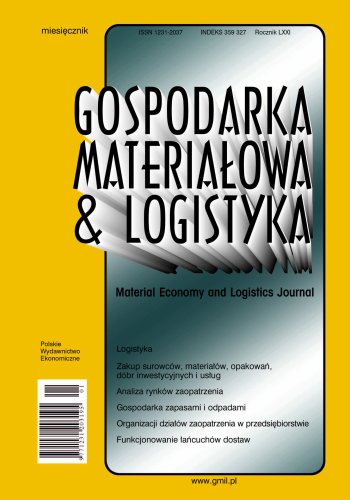Apropriacja renty sieciowej w triadycznym łańcuchu dostaw
Współczesne łańcuchy dostaw są często analizowane z perspektywy układów triadycznych, która umożliwia zrozumienie złożoności i dynamiki zmian zachodzących w strukturach międzyorganizacyjnych. W niniejszym artykule wykorzystano dwa podstawowe rodzaje związków triadycznych — lukę strukturalną oraz układ zamknięty — do prezentacji problematyki generowania renty sieciowej w łańcuchach dostaw. Ważnym i wciąż aktualnym problemem w funkcjonowaniu współczesnych łańcuchów dostaw jest bowiem nierównomierny podział renty sieciowej wynikającej ze współpracy międzyorganizacyjnej. W związku z tym celem artykułu jest rozpoznanie i wyjaśnienie zjawiska apropriacji (zawłaszczania) renty sieciowej w triadycznych łańcuchach dostaw. Ponadto w artykule zasygnalizowano możliwość estymacji renty sieciowej w praktyce funkcjonowania łańcuchów dostaw.
Bibliografia
Bibliografia/References
Bromiley, P., Rau, D. (2014). Towards a practice-based view of strategy. Strategic Management Journal, 35(8), 1249–1256. https://doi.org/10.1002/smj.2238
Burt, R. S. (1992). Structural Holes. Cambridge, Massachusetts: Harvard University Press.
Burt, R. S. (1997). The Contingent Value of Social Capital. Administrative Science Quarterly, 42(2), 339–365. https://doi.org/10.2307/2393923
Burt, R. S. (2000). The network structure of social capital. Research in Organizational Behaviour, 22, 345–423.
Carter, C. R., Kosmol, T., Kaufmann, L. (2017). Toward a Supply Chain Practice View. Journal of Supply Chain Management, 53(1), 114–122. https://doi.org/10.1111/jscm.12130
Chae, S. (2018). Horizontal versus vertical structural holes in supply networks: Contrasting performance implications for focal firms, Proceedings of the 20th EurOMA Conference, 24–26 June, Budapest.
Choi, T. Y., Wu, Z. (2009a). Triads in supply networks: theorizing buyer-supplier-supplier relationships. Journal of Supply Chain Management, 45(1), 8–25. https://doi.org/10.1111/j.1745-493x.2009.03151.x
Choi, T. Y., Wu, Z. (2009b). Taking the leap from dyads to triads: Buyer-supplier relationships in supply networks. Journal of Purchasing and Supply Management, 15(4), 263–266. https://doi.org/10.1016/j.pursup.2009.08.003
Coleman, J. S. (1988). Social Capital in the Creation of Human Capital. American Journal of Sociology, 94, 95–120.
Coleman, J. S. (1990). Foundations of Social Theory. Cambridge, MA: Harvard University Press.
Cooper, M. C., Ellram, L. M., Gardner, J. T., Hanks, A. M. (1997). Meshing multiple alliances. Journal of Business Logistics, 18(1), 67–89.
Czakon, W. (2012). Sieci w zarządzaniu strategicznym. Warszawa: Wolters Kluwer.
Duschek, S. (2004). Inter-firm resources and sustained competitive advantage. Management Review, 15(1), 53–73. https://doi.org/10.5771/0935-9915-2004-1-53
Dyer, J. H., Singh, H. (1998). The relational view: cooperative strategy and sources of interorganizational competitive advantage. Academy of Management Review, 23(4), 660–679. https://doi.org/10.5465/amr.1998.1255632
Ellram, L. M., Cooper, M. C. (1993). The relationship between Supply Chain Management and Keiretsu. International Journal of Logistics Management, 4(1), 1–12. https://doi.org/10.1108/09574099310804911
Håkansson, H., Persson, G. (2004). Supply Chain Management: The logic of supply chains and networks. International Journal of Logistics Management, 15(1), 11–26. https://doi.org/10.1108/09574090410700202
Kogut, B. (2000). The network as knowledge: generative rules and the emergence of structure. Strategic Management Journal, 21, 405–425. https://doi.org/10.1002/(sici)1097-0266(200003)21:3<405::aid-smj103>3.0.co;2-5
Lavie, D. (2006). The competitive advantage of interconnected firms: An extension of the Resource-Based View. Academy of Management Review, 31(3), 638–658. https://doi.org/10.5465/amr.2006.21318922
Li, M., Choi, T. Y. (2009). Triads in services outsourcing: bridge, bridge decay and bridge transfer. Journal of Supply Chain Management, 45, 27–39. https://doi.org/10.1111/j.1745-493x.2009.03169.x
Mańkowski, C. (2010). Synergia w logistyce. Gdańsk: Wydawnictwo Uniwersytetu Gdańskiego.
Mena, C., Humphries, A., Choi, T. Y. (2013). Toward a theory of Multi-Tier Supply Chain Management. Journal of Supply Chain Management, 49(2), 58–77. https://doi.org/10.1111/jscm.12003
Mentzer, J. T., DeWitt, W., Keebler, J. S., Min, S., Nix, N. W., Smith, C. D., Zacharia, Z. G. (2001). Defining Supply Chain Management. Journal of Business Logistics, 22, 1–25. https://doi.org/10.1002/j.2158-1592.2001.tb00001.x
Mitręga, M. (2010). Zdolność sieciowa jako czynnik przewagi konkurencyjnej na rynku przedsiębiorstw. Katowice: Wydawnictwo Akademii Ekonomicznej w Katowicach.
Niemczyk, J. (2013). Strategia. Od planu do sieci. Wrocław: Wydawnictwo Uniwersytetu Ekonomicznego we Wrocławiu.
Obstfeld, D. (2005). Social networks, the tertius iungens orientation, and involvement in innovation. Administrative Science Quarterly, 50, 100–130. https://doi.org/10.2189/asqu.2005.50.1.100
Shaw, S., Grant, D. B., Mangan, J. (2021). A supply chain practice-based view of enablers, inhibitors and benefits for environmental supply chain performance measurement. Production Planning & Control, 32(5), 382–396. https://doi. org/10.1080/09537287.2020.1737977.
Sołtysik, A. (2003), Zarządzanie logistyczne. Katowice: Wydawnictwo Akademii Ekonomicznej w Katowicach.
Świerczek, A. (2020a). Konceptualizacja roli zakorzenienia społecznego w osiąganiu sieciowej przewagi konkurencyjnej triadycznych łańcuchów dostaw. Gospodarka Materiałowa i Logistyka, (1), 2–10. https://doi.org/10.33226/1231-2037.2020.1.1
Świerczek, A. (2020b). Dynamika kształtowania więzi sieciowych w łańcuchu dostaw. Perspektywa triadyczna. Gospodarka Materiałowa i Logistyka, (10), 2–11. https://doi.org/10.33226/1231-2037.2020.10.1
Wu, Z., Choi, T. Y. (2005). Supplier-supplier relationships in the buyer-supplier triad: Building theories from eight case studies. Journal of Operations Management, 24(1), 27–52. https://doi.org/10.1016/j.jom.2005.02.001
Wynstra, F., Spring, M., Schoenherr, T. (2015). Service triads: A research agenda for buyer-supplier-customer triads in business services. Journal of Operations Management, 35, 1–20. https://doi.org/10.1016/j.jom.2014.10.002

